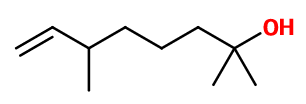Dihydromyrcenol
Synthétique
Floral > Fresh Flowers > Rosy > Zesty

Crédits photo: ScenTree SAS
Other names :
2,6-dimethyloct-7-en-2-ol ; DHM ; Dihydro myrcenol ; Dihydromyrcenate ; 2,6-dimethyloct-7-enol ; Floralym ; Lymolene ; Myrcetol
Volatility :
Heart
Uses in perfumery :
Dihydromyrcenol is used in zesty and fougere accords, and to give a fresh nuance to fruity notes.
Natural availability :
Dihydromyrcenol is very poorly present in nature. It is therefore in most cases the synthetic version that is used in perfumery.
Year of discovery :
1956
Other comments :
Comparing it with Dimethyl Benzyl Carbinol and Dimetol®, Dihydromyrcenol has a more zesty note, reminiscent of numerous masculine perfumes.
Price Range :
€€
Stability :
Terpenes tend to polymerize by oxydation.

Crédits photo: ScenTree SAS
- Molecular formula :
- C10H20O
- Molecular Weight :
- 156,27 g/mol
- Density :
- 0,784
- Flash Point :
- 77°C
- Fusion Point :
- Donnée indisponible.
- Appearance :
- Colorless liquid
- Log P :
- 3,25
- Boiling Point :
- 196°C
- Detection Threshold :
- Donnée indisponible.
Synthesis route :
The synthesis of Dihydromyrcenol starts from cis-pinane, which is pyrolyzed to give an intermediate product called Citronellene. To obtain Dihydromyrcenol, the process can be achieved in three different ways : the first one is to put hydrochloric acid in contact with Citronellene, followed by a hydrolysis. The second is the addition of formic acid to saponify the resulting Dihydromyrcenyl Formate. The last one is a direct acid hydrolysis in the presence of sulfuric acid.
Synthesis precursor :
Dihydromyrcenol is an intermediary in the synthesis of Tetrahydromyrcenol and a reagent in the synthesis of Dihydromyrcenyl acetate and other esters of this alcohol.
Isomerism :
Dihydromyrcenol has an asymmetric carbon. However, it is the racemic mixture of the two enantiomers that is used in perfumery. Citronellol and Rosalava are constitutional isomers of Dihydromyrcenol. Both also have a rosy smell, more lemony for Citronellol and more intense for Rosalva®.
- EINECS number :
- 242-362-4
- FEMA number :
- Donnée indisponible.
- JECFA number :
- Donnée indisponible.
- FLAVIS number :
- 02.144
- Allergens :
- This ingredient does not contain any allergen.
- IFRA :
- This ingredient is not restricted
To learn more about IFRA's standards : https://ifrafragrance.org/safe-use/library
ScenTree is solely responsible for the information provided here.

